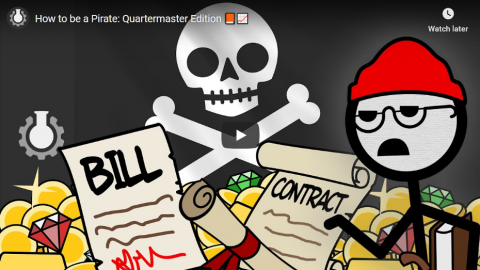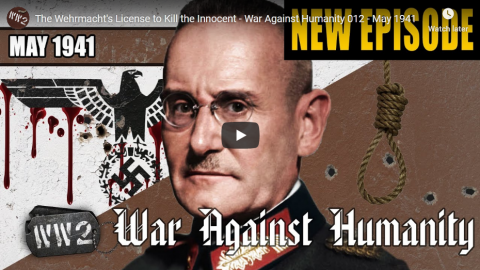CGP Grey
Published 2 Jun 2020‣ Adapted largely from The Invisible Hook. It’s great, go read it: https://amzn.to/36PLKSE
‣ Director’s Commentary later today: https://www.patreon.com/cgpgrey## Special Thanks
Peter T. Leeson for reviewing a draft of the script. Check out his newest book, WTF?!: An Economic Tour of the Weird: https://amzn.to/3eEMm09
## Crowdfunders
Steven Snow, Bob Kunz, John Buchan, Nevin Spoljaric, Donal Botkin, BN-12, Chris Chapin, Richard Jenkins, Phil Gardner, Martin, سليمان العقل, Steven Grimm, Colin Millions, Saki Comandao, Jason Lewandowski, Andrea Di Biagio, David F Watson, Ben Schwab, Elliot Lepley, rictic, Bobby, Marco Arment, Shallon Brown, Shantanu Raj, emptymachine, George Lin, Henry Ng, Jeffrey Podis, Thunda Plum, Awoo, David Tyler, Derek Bonner, Derek Jackson, Fuesu, iulus, Jordan Earls, Joshua Jamison, Mikko, Nick Fish, Nick Gibson, Orbit_Junkie, Ron Bowes, Tómas Árni Jónasson, Tyler Bryant, Zach Whittle, Oliver Steele, Kermit Norlund, Kevin Costello, Ben Delo, Arctic May, Bear, chrysilis, David Palomares, Emil, Erik Parasiuk, Esteban Santana Santana, Freddi Hørlyck, Frederick The Great, John Rogers, ken mcfarlane, Leon, Maarten van der Blij, Peter Lomax, Rhys Parry, ShiroiYami, Tijmen van Dien, Tristan Watts-Willis, Veronica Peshterianu, Dag Viggo Lokøen, John Lee, Maxime Zielony, Bryan McLemore, Elizabeth Keathley, Alex Simonides, Felix Weis, Melvin Sowah, Giulio Bontadini, Paul Alom, Ryan Tripicchio, Scot Melville
## Music
David Rees: http://www.davidreesmusic.com
June 3, 2020
How to be a Pirate: Quartermaster Edition 



Fanatics gonna fanatic … they can’t help it
It’s funny that no matter what the claimed crisis, the answers always go in the same direction, as Kristian Niemietz points out with the demands to turn our still unending lockdown toward “protecting the environment”:
The change, superficially, is to encourage “a safe return to work” allowing more social distancing between pedestrians, but more substantially in order to preserve the cleaner air that has resulted from the lockdown.
The health and safety excuse for the policy change can be largely dismissed. The simple truth of the pandemic and national policy is that if social distancing matters, the centre of London is not safe to return to work. It is too densely populated and almost entirely reliant on mass transit which cannot operate above 10-15% capacity with 2m exclusion rules. With average commutes over 9 miles each way, substitution effects to walking and cycling will be extremely limited and temporary.
It is then hard to see then how the policy’s architects imagine the streets will fill up to the extent urgent measures are needed. Conversely, if social distancing does not matter (and it will cease to matter eventually), then a policy to enable more social distancing outside by widening the pedestrian streetscape is redundant. If it is safe to sit on a crowded train, it is safe to walk on a crowded pavement. It is not hard then to cut through the pandemic packaging to note that the motive for this policy is opportunistic, to accelerate a pedestrianisation plan that is the dream of many an urban planner.
Many will see this as self-evidently a good thing. Removing vehicle traffic from densely populated narrow streets will reduce air pollution, congestion and road traffic accidents. As a policy it will have more supporters than opponents; very few people drive into the centre of London to commute and there is very little capacity for parking. London’s leaders are not wrong to think that this is the future, the question is really one of timing and how they go about it, which is far more difficult and does not have anything to do with managing a coronavirus.
What the pandemic allows is the ability to use emergency powers for something that is not an emergency. This matters, in normal times it took several years to close one dangerous junction at Bank to most traffic, and this under a hail of protests from local businesses and taxi drivers. The same result can now be achieved in a few weeks across many streets. The democratic checks and balances that differentiate the UK from authoritarian states can be ditched and London officialdom granted extraordinary powers to do as they please. If the protestors don’t like it this time, they should note the right to protest has also been suspended, at least for now.
Inglis High Power: How a Chinese Whim Became A British Service Pistol
Forgotten Weapons
Published 25 Jan 2018Sold for $3,163.
During World War Two, the Canadian government set up a loan program to help Chinese companies provide all manner of material aid to Canada’s allies. Among many others, one recipient of this aid was the Nationalist Chinese government under Chiang Kai Shek. Chinese representatives asked the John Inglis company to manufacture no less than 180,000 Browning High Power pistols, and the company agreed.
After some wrangling, Inglis acquired a license from FN representatives to make the guns, got a complete technical package through the British government and FN’s representatives in exile, and the direct personal aid of Laloux and Saive from FN. Delivery proved difficult, though, with only about 4000 guns being shipped to Karachi and then needing to be flown over The Hump in cargo planes, along with massive amounts of other aid — and a few pistols didn’t get a lot of priority there.
By the fall of 1944, the contract was cancelled under concerns that it was not really contributing to any progress in the war against the Japanese, along with insistence from American General Stilwell that the Chinese forces be armed with weapons that could be supplied more easily through the American logistic network. Production restarted after the defeat of Germany, with another 40,000 or so being made and delivered before it was cancelled again when the Nationalist Chinese forces were seen to be clearly losing to their Communist opponents.
Each of these pistols was supplied with a combination shoulder stock and holster. In the US, attaching a stock to a pistol would normally subject it to registration as a Short Barreled Rifle, but the Inglis High Powers are among the guns exempted from this requirement. They are, in fact, among the least expensive and most modern guns to be exempted in this way.
http://www.patreon.com/ForgottenWeapons
Cool Forgotten Weapons merch! http://shop.bbtv.com/collections/forg…
If you enjoy Forgotten Weapons, check out its sister channel, InRangeTV! http://www.youtube.com/InRangeTVShow
QotD: From “the media’s” point of view
But what if they’re right? The media are most often accused of three things: bias, sensationalism and negativity.
Bias. Everyone leans a certain way politically. Ideally, that wouldn’t affect the way a reporter covered a city council meeting or a police news conference. But to tell the truth, I’ve probably worked with 10 times more liberal-leaning journalists than conservative-leaning journalists over the past three decades. The profession attracts people with an affinity for underdogs. That has to have some impact on the stories we choose to do and the ones we don’t.
Sensationalism. It depends how you define it. If we talk to the relatives of a murder victim, are we doing it to make money? I hope we’re there because we’re trying help the community grieve together. But let’s face it, that story is going to be well-read so maybe it will make more money in some click-based, page-view algorithm that I’ll never understand.
Negativity. We don’t make cars crash. We don’t bomb civilians. The world can be an ugly place and these things won’t stop if we ignore them. On the other hand, I haven’t met many reporters who would rather cover a parade than a murder trial. Darker stories seem, by their nature, more important. So maybe we are negative.
But I’ve already fallen into the trap of thinking in terms of “us” and “them.” There should be no distinction. It’s here where the media are their own worst enemies. We tend to think we’re infallible because we’re doing God’s work. But if we want more people on our side, we could do a much better job of showing the public what we do, why we do it and how we do it. We like to crow about open courts, but what about open newsrooms?
Maybe we should trust people enough to let them in on the process. To boil it down to one example, if the police shoot an Indigenous man and we decide to mention his race in coverage, we should tell people why we thought it was relevant and maybe admit that we agonize over such decisions. It might not stop the haters but it would at least give “them” a chance to understand “us.”
Cam Fuller, “Do people really hate us and if so, why?”, Saskatoon StarPhoenix, 2018-03-03.







